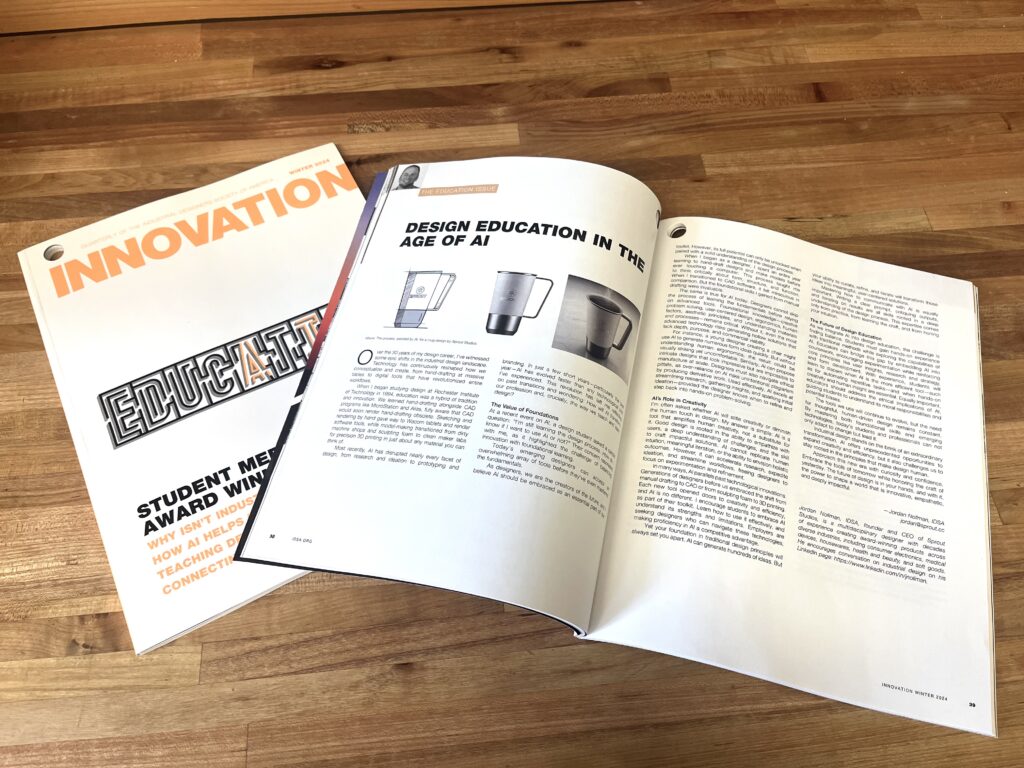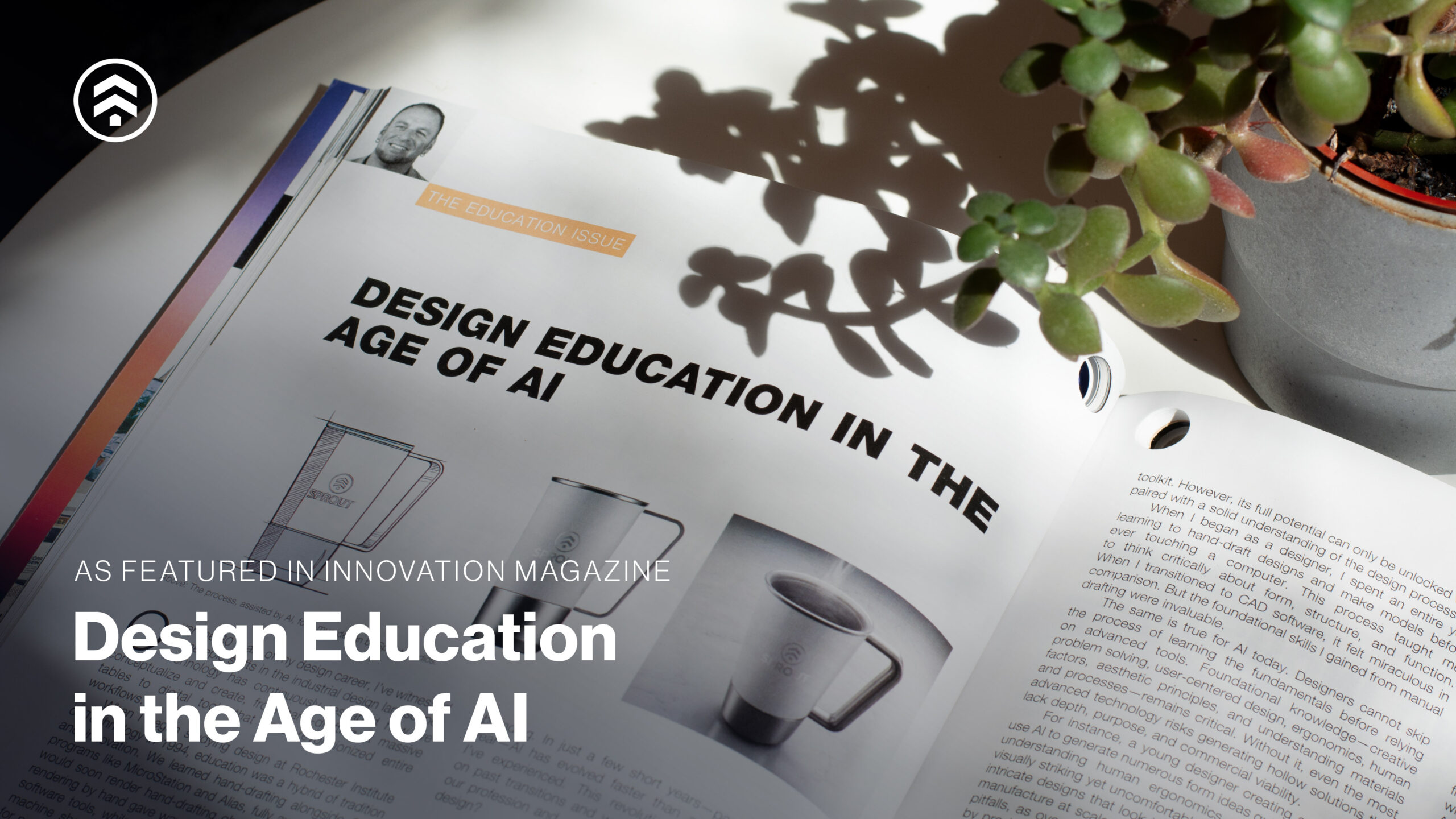Recently, IDSA invited us to contribute to an education-focused issue of INNOVATION magazine, exploring how emerging technologies—particularly AI—are reshaping design education. In the article, we reflect on the importance of balancing new tools with foundational skills, and what today’s students need to thrive in an evolving industry. You can read the full article below, and discover more insights from industry leaders in the latest issue of INNOVATION magazine.

Over the 30 years of my design career, I’ve witnessed some epic shifts in the industrial design landscape. Technology has continuously reshaped how we conceptualize and create, from hand-drafting at massive tables to digital tools that have revolutionized entire workflows.
When I began studying design at Rochester Institute of Technology in 1994, education was a hybrid of tradition and innovation. We learned hand-drafting alongside CAD programs like MicroStation and Alias, fully aware that CAD would soon render hand-drafting obsolete. Sketching and rendering by hand gave way to Wacom tablets and render software tools, while model-making transitioned from dirty machine shops and sculpting foam to clean maker labs for precision 3D printing in just about any material you can think of.
Most recently, AI has disrupted nearly every facet of design, from research and ideation to prototyping and branding. In just a few short years—particularly the past year—AI has evolved faster than any technological shift I’ve experienced. This revolution has left me reflecting on past transitions and wondering: How will AI transform our profession and, crucially, the way we teach and learn design?
The Value of Foundations
At a recent event on AI, a design student asked a candid question: “I’m still learning the design process. How do I know if I want to use AI or not?” Their concern resonated with me, as it highlighted the challenge of balancing innovation with foundational learning.
Today’s emerging designers can access an overwhelming array of tools before they’ve even mastered the fundamentals.
As designers, we are the creators of the future, and I believe AI should be embraced as an essential part of our toolkit. However, its full potential can only be unlocked when paired with a solid understanding of the design process.
When I began as a designer, I spent an entire year learning to hand-draft designs and make models before ever touching a computer. This process taught me to think critically about form, structure, and function. When I transitioned to CAD software, it felt miraculous in comparison. But the foundational skills I gained from manual drafting were invaluable.
The same is true for AI today. Designers cannot skip the process of learning the fundamentals before relying on advanced tools. Foundational knowledge—creative problem solving, user-centered design, ergonomics, human factors, aesthetic principles, and understanding materials and processes—remains critical. Without it, even the most advanced technology risks generating hollow solutions that lack depth, purpose, and commercial viability.
For instance, a young designer creating a chair might use AI to generate numerous form ideas quickly, but without understanding human ergonomics, the result could be visually striking yet uncomfortable. Similarly, AI can propose intricate designs that look impressive but are impossible to manufacture at scale. Designers must also navigate ethical pitfalls, as over-reliance on AI risks unintentional plagiarism by producing derivative work. Used effectively, AI excels at streamlining research, gathering insights, and sparking initial ideation—provided the designer knows when to refine and step back into hands-on problem-solving.
AI’s Role in Creativity
I’m often asked whether AI will stifle creativity or diminish the human touch in design. My answer is simple: AI is a tool that amplifies human creativity, not a substitute for it.
Good design is rooted in the ability to empathize with users, a deep understanding of challenges, and the skill to craft impactful solutions. AI cannot replicate human intuition, meaningful iteration, or the ability to envision holistic outcomes. However, it can accelerate research, expedite ideation, and streamline workflows, freeing designers to focus on experimentation and refinement.
In many ways, AI parallels past technological innovations. Generations of designers before us embraced the shift from manual drafting to CAD or from sculpting foam to 3D printing. Each new tool opened doors to creativity and efficiency, and AI is no different.
I encourage students to embrace AI as part of their toolkit. Learn how to use it effectively, and understand its strengths and limitations. Employers are seeking designers who can navigate these technologies, making proficiency in AI a competitive advantage.
Yet your foundation in traditional design principles will always set you apart. AI can generate thousands of ideas. But your ability to curate, refine, and iterate will transform those ideas into meaningful, user-centered solutions.
Mastering how to communicate with AI is equally important. Writing a clear prompt, critiquing outputs, and iterating on results are all skills rooted in a deep understanding of the design process. This expertise comes only from practice, from learning the craft, and from honing your intuition.
The Future of Design Education
As we integrate AI into design education, the challenge is finding balance. Students must gain hands-on experience with traditional methods while exploring the capabilities of AI. Educators can bridge this gap by embedding AI into coursework, encouraging experimentation while reinforcing core principles like user insights, research and strategy, and form development. With experience, students will learn to discern when AI is the more efficient tool—such as for automating repetitive tasks—and when hands-on creativity and human insight are essential. Equally important, educators should address the ethical implications of AI, guiding students to understand its moral responsibilities and potential biases.
The tools we use will continue to evolve, but the need for thoughtful, human-driven design remains constant. By mastering both foundational skills and emerging technologies, today’s students and professionals can not only adapt to change but lead it.
Industrial design stands on the brink of an extraordinary transformation. AI offers unprecedented opportunities to expand creativity and efficiency, but it also challenges us to stay rooted in the principles that make design human.
Approach this new era with curiosity and confidence. Embrace the tools of tomorrow while honoring the craft of yesterday. The future of design is in your hands, and with it, the power to shape a world that is innovative, empathetic, and deeply impactful.


